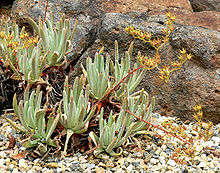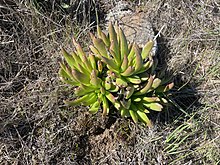| Green liveforever | |
|---|---|

| |
| Dudleya virens ssp. hassei | |
|
Scientific classification
| |
| Kingdom: | Plantae |
| Clade: | Tracheophytes |
| Clade: | Angiosperms |
| Clade: | Eudicots |
| Order: | Saxifragales |
| Family: | Crassulaceae |
| Genus: | Dudleya |
| Species: | D. virens
|
| Binomial name | |
| Dudleya virens | |
| Synonyms [1] | |
| |


Dudleya virens, the green liveforever or bright green dudleya, is an uncommon species of perennial, succulent plant in the family Crassulaceae, native to several coastal southern California and Baja California locations. [2]
Distribution
The succulent is found growing in the Palos Verdes Hills on the Palos Verdes Peninsula coast in Los Angeles County; on several of the Channel Islands in California; and on Guadalupe Island off the northwestern Baja California Peninsula, Mexico.
Description
Dudleya virens leaves are fleshy and strap-shaped, 8–20 cm long and 1.5–3 cm broad, tapering from the base (or from near middle) and are mostly green. They are arranged in a rosette.
The flowers are white, with five petals 7–10 mm long. They are produced in April, May, and June. Hummingbirds visit the flowers for their nectar.
Subspecies
| Name | Authority | Common name | Distribution | Image |
|---|---|---|---|---|
| Species Dudleya virens (Rose) Moran | ||||
| D. v. subsp. extima | ||||
| subsp. extima | Moran | Guadalupe green liveforever | Endemic to Guadalupe Island | |
| Caudex 1 to 2.5 cm thick, either branching into clumps of up to 15 rosettes or elongating up to 30 cm. Rosettes are 5 to 15 cm wide, containing 15 to 55 crowded leaves. Leaves are bright green or glaucous. Leaf shape is linear to oblong-oblanceolate, 4 to 7 or rarely up to 17 cm long, 6 to 10 mm wide above when linear but up to 15 mm wide above when oblanceolate, 8 to 15 mm wide at the base and 2 to 4 mm thick. Peduncle 5 to 20 cm tall, 2 to 5 mm thick, inflorescence 2 to 7 cm wide, composed of 2 to 4 ascending branches. Flowers are white with petals 7 to 10 mm long. Chromosomes n = 17, 34. [3] | ||||
| D. v. subsp. hassei | ||||
| subsp. hassei
syn. Stylophyllum hassei syn. Cotyledon hassei syn. Echeveria hassei syn. Dudleya hassei |
(Rose) Moran
[3]
Rose in Britton & Rose [4] (Rose) Fedde [5] (Rose) Berger [6] (Rose) Moran [7] |
Catalina Island liveforever | Endemic to Santa Catalina Island. |  |
| Caudex 1 to 3 cm thick, branching into clumps 1 m wide. Rosettes are 4 to 8 cm wide, containing 15 to 30 erect leaves. Leaves are generally glaucous, but rarely can be green. Leaf shape is linear-oblong to linear-lanceolate and 5 to 10 cm long, 2 to 4 mm thick. Peduncle 10 to 30 cm tall, inflorescence branching into 2 to 4 close set or once bifurcate branches. Flowers are white with petals 8 to 10 mm long. Chromosomes n = 34. [8] | ||||
| D. v. subsp. insularis | ||||
| subsp. insularis
syn. Stylophyllum insulare syn. Cotyledon insularis syn. Cotyledon viscida var. insularis syn. Echeveria insularis syn. Echeveria viscida var. insularis syn. Dudleya insularis |
(Rose) Moran
Rose in Britton & Rose [4] (Rose) Fedde [5] (Rose) S. Watson [9] (Rose) Berger [6] (S. Watson) Berger [10] (Rose) P. H. Thomson [11] |
Island green dudleya | Occurs in the Palos Verdes Hills, Santa Catalina and San Nicolas islands. |  |
| Caudex 2 to 6 cm thick, up to 1 m long, branching into clumps 2 m wide. Rosettes are 10 to 25 cm wide, containing 20 to 50 spreading to erect leaves. Leaves sometimes glaucous, sometimes green. Leaf shape is triangular-lanceolate, 6 to 25 cm long and 10 to 32 mm wide above, 2 to 4 cm wide at the base, with an obtuse tip. Peduncle 6 to 70 cm tall, 5 to 15 mm thick. Flowers are white with red to orange keels, petals 8 to 10 mm long. Chromosomes n = 17. [12] | ||||
| D. v. subsp. virens | ||||
| subsp. virens
syn. Stylophyllum virens syn. Cotyledon virens syn. Echeveria virens syn. Dudleya virens syn. Stylophyllum albida syn. Cotyledon albida syn. Echeveria albida syn. Dudleya albida |
(Rose) Moran
Rose in Britton & Rose [4] (Rose) Fedde [5] (Rose) Berger [6] (Rose) Moran [13] Rose in Britton & Rose [4] (Rose) Fedde [5] (Rose) Berger [6] (Rose) P. H. Thomson [11] |
Bright green dudleya
Alabaster plant |
Endemic to San Clemente Island. |  |
| Caudex 1 to 3.2 cm wide, branching into clumps at least 40 cm wide. Rosettes are 5 to 10 cm wide, containing 20 to 50 leaves. Leaves are usually green, rarely glaucous. Leaf shape is triangular-lanceolate to linear-lanceolate, 3 to 10 cm long and 10 to 15 mm wide above, 1.5 to 3 cm wide at the base, with an acute tip. Peduncle is 7 to 46 cm long, 4 to 7 mm thick, inflorescence 6 to 15 cm wide with 3 to 4 close-set branches towards the apex. Flowers are white with red to orange keels, petals 8 to 10 mm long. Chromosomes n = 17. [14] | ||||
Cultivation
Dudleya virens is cultivated as an ornamental plant in the specialty native plants and succulents horticulture trade. [15] It is used in containers, drought tolerant landscapes, and habitat gardens. It prefers well-draining soil, and grows best in full sun or light shade.
References
- ^ The Plant List: A Working List of All Plant Species, retrieved 9 July 2016
- ^ Calflora Database: Dudleya virens . accessed 6.30.2013
- ^ a b Moran, Reid (1995). "THE SUBSPECIES OF DUDLEYA VIRENS (CRASSULACEAE)". Haseltonia. 3: 4.
- ^ a b c d Bull. New York Bot. Gard. 3(9): 34-35. 1903
- ^ a b c d Just's Bot. Jahresber. 31(1): 829. 1904.
- ^ a b c d Engler, Nat. Pflanzenfam. ed. 2, 18a: 480. 1930
- ^ Moran, Reid (1957). "Dudleya hassei". Madroño. 14: 108.
- ^ McCabe, Stephen Ward (2012). "Dudleya virens subsp. hassei". Jepson eFlora. Jepson Flora Project (eds.). Archived from the original on 2017-08-29.
- ^ Jeps., Man. Fl. Pl. Calif, p. 453. 1925.
- ^ (Rose) Jeps., Fl. Calif. 2: 115. 1936.
- ^ a b Dudleya Hasseanthus handbook, p. 80, 240-241. 1993
- ^ McCabe, Stephen Ward (2012). "Dudleya virens subsp. insularis". Jepson eFlora. Jepson Flora Project (eds.). Archived from the original on 2017-08-29.
- ^ Moran, Reid (1943). "Dudleya virens". Desert Plant Life. 14: 191.
- ^ McCabe, Stephen Ward (2012). "Dudleya virens subsp. virens". Jepson eFlora. Jepson Flora Project (eds.). Archived from the original on 2016-04-03.
- ^ Rancho Santa Ana Botanic Garden: Native Plants for Coastal Gardens Archived 2015-09-24 at the Wayback Machine . accessed 6.30.2013
External links
- Dudleya
- Flora of California
- Flora of Baja California
- Flora of Mexican Pacific Islands
- Natural history of the California chaparral and woodlands
- Natural history of the Channel Islands of California
- Natural history of the Peninsular Ranges
- Natural history of Los Angeles County, California
- Taxa named by Reid Venable Moran
- Garden plants of North America
- Drought-tolerant plants